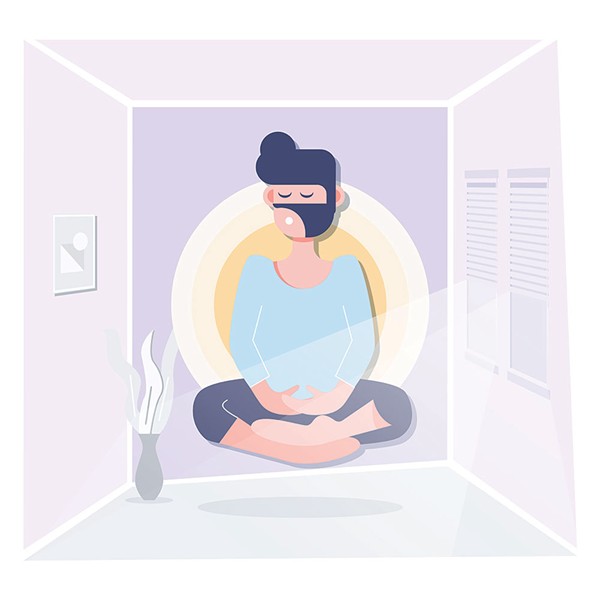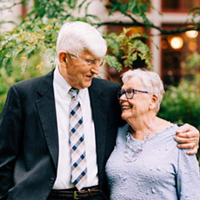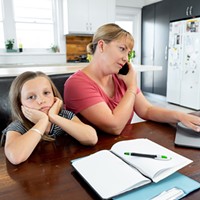This morning, like many of you reading this, I woke hoping it had passed. That we could proceed with our lives as we lived them prior to COVID-19. But alas, we are living this new reality of "social distancing" and "shelter-in-place." Cable news networks are committed to ongoing analysis and release of information, and social media sites are saturated with memes, activities, suggestions and humor — in an attempt to make sense of all of this.
In discussing this unprecedented time with friends and colleagues, many have tried to explain the unexplainable — what I visualize as a veil of uncertainty and, for many, an almost palpable awareness of what may be described as a global anxiety. Some of us have children who are seeing this and we witness them trying to make sense of it as well. And depending on the child's developmental age, there are very different degrees of understanding. What's universal is the fear and anxiety. While falling asleep a week ago, my 9-year-old daughter said, "Daddy, I'm scared and I don't know why." A lot has happened since March 15 and the landscape of COVID-19 continues to shift. As we support each other, our children and our elders — whether under the same roof or not — there have been some helpful basic strategies identified to help reduce anxiety and maintain emotionally healthy environments. These may be a reminder of what you have already read but they are very helpful in practice. Like frequent and thorough hand washing, it is important to be intentional in our efforts toward maintaining emotional wellness.
Take care of your physical self: As most of us know, getting enough sleep, washing our hands, limiting contact with others, having necessary medications, and avoiding tobacco, alcohol and other drugs are all highly recommended. The challenge is that stress can be a trigger for vices and unhealthy behaviors. Be mindful of your physical practice, as well as the care and nutrition of your children and other family. (Our local school districts are also working vigilantly to distribute food during this time. For more information, visit www.hcoe.org/covid-19-2/school-meal-times-and-locations.)
Fortunately we live in a region where we can access outdoor activities while maintaining social distancing. Whether it's moving indoors (yoga, stretching or jumping jacks) or outdoors (walking, running or bike riding), it is essential to find some physical activity that suits your needs and ability.
Maintain social connections: Whether an introvert or an extrovert, it's important to maintain connections with your family, community and colleagues. It is also important for your children to remain connected with their family, friends, teachers and classmates. Fortunately, we live in an era in which technology greatly facilitates connection. It is connection that brings us together and assists with alleviating the inherent isolation of "social distancing." We are social creatures who often work in collective groups. The majority of our schools promote group experiences, as do many leisure activities, whether it be community gatherings (Arts Alive!), the movies, sports events, prom, church ... the list goes on. Keep in mind that a good, old-fashioned phone call is still an excellent means to maintain connections.
Take Breaks: Take the time to do things you enjoy or to do nothing at all. Mindfulness can be as simple as taking deep breaths (i.e. four seconds to inhale, hold it for four seconds, followed by four seconds to release) in a series of four to five. Progressive muscle relaxation is another approach to calming the body. For kids, a mindful activity could be blowing bubbles, blowing up balloons or intentionally eating a piece of fruit (looking at the shape, regarding the smell, focusing on the taste). Building calming breaks into the day is a thoughtful step toward anxiety management. Searching "mindful activities for children" online will provide many fun and calming activities.
Managing media consumption: It is important to be informed during this time, and paying attention to local and national news is part of that. Many also rely on social media such as Facebook, Instagram and Twitter to remain connected. And while all are useful, it's essential to be thoughtful of the consumption. Taking breaks from screens will make room for other important activities. Another piece to strongly consider is who is viewing and/or listening. Some of the chyrons and conversations on news channels can be potentially scary and anxiety producing for children, as well as the rest of us. Creating windows to watch the news, while being mindful of the audience, is one way to care for everyone's emotional well-being. Also keep in mind when you are expressing your own fears and anxiety that, while it's good to be honest about our feelings, it's important to protect our children by providing them with a sense of safety and optimism.
Maintaining and establishing routine: The predictability and maintenance of routines and rituals adds a sense of calm and comfort for everyone. Examples of this could be sharing a meal together, reading to your child before bed or taking a morning walk. I have actually seen suggested COVID-19 home schedule examples for children, as a way to manage schoolwork, physical activities, chores, creative fun time and the like. For many this approach can provide a roadmap for the day, while teaching an important organizational skill. Keep in mind that communication and providing children time to voice their perceptions and concerns is powerful medicine. As is assuring children that they are safe and cared for — this is important for all kids, regardless of age.
Quality time: Within all of this, prioritize time to nurture children and anyone else around you in this time of uncertainty. Reading, art, gardening, cooking, bedtime, meal time, listening to music, playing an instrument or enjoying nature are just some of the activities that offer opportunities for quality time. Be mindful of the "golden ratio," something I often share with teachers, which holds that a mentally healthy environment is one in which you give four positive statements to every one corrective statement (4:1). While we are human and we may not be able to adhere to this all the time, it is something to strive for. People are much more likely to repeat a behavior when it is positively reinforced, research has affirmed this premise many times over. So "catch each other being good" and recognize preferred behavior. Children who are recognized for their success and their attempts to correct themselves build positive understandings of their skill and ability. This also contributes to the development of a positive self-identity. While it's essential to correct behavior, it is even more meaningful to learning when, after correcting the behavior, subsequent successful behavior is upheld in a positive light. This is true with adult to adult communications as well.
These are all elements to help us curb the potential of "cabin fever" and move through this time with as much grace and understanding as possible. We are embarking into an unknown wilderness and it's good to have some of the necessary gear in our packs. Let's support each other as we move through this together.
If you need assistance for mental health crisis, call 445-7715, or 911 in the event of emergency.
Dr. Peter Stoll is a credentialed school psychologist and administrator and prefers he/him pronouns. He is a program director for the Humboldt County Office of Education and the Humboldt-Del Norte SELPA.
Editor's note: This is one of three columns this week looking at how to maintain wellness for you and your family while shelter in place. Find the other parts here and here.




Comments